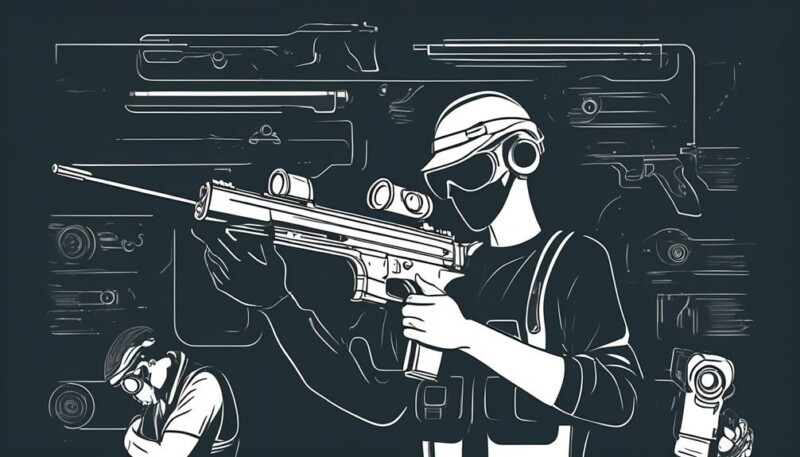Just as a carpenter needs to understand the intricacies of his tools to create masterpieces, you too must comprehend firearm safety and terminology to ensure responsible and informed gun usage.
This knowledge isn't simply about wielding a weapon; it's about recognizing the potential risks and rewards that come with owning such a powerful tool.
From the difference between a semi-automatic and an automatic weapon, to the critical importance of safely storing your firearm, these are not just terms or guidelines.
They are the foundation of preventing unnecessary accidents and promoting responsible ownership.
As you journey through this discussion, you'll discover the essential role this understanding plays, both for individual gun owners and the broader community.
Key Takeaways
- Understanding firearm safety and terminology is essential for responsible gun ownership.
- Knowledge of firearm jargon enhances communication within the firearms community and aids in making informed decisions when purchasing firearms and accessories.
- Proper training in firearm safety rules and responsibilities prevents accidental shootings and promotes responsible gun use and handling.
- Continuously seeking advanced training and skill development prepares individuals for high-stress situations and improves their ability to handle firearms effectively.
The Basics of Firearm Safety
When handling a firearm, your safety hinges on understanding and consistently following a set of key principles. This is where the basics of Firearms Safety come in. Let's delve into those principles.
Firstly, you should always treat every gun as if it's loaded. Even if you're sure it isn't, it's better to be safe than sorry.
Secondly, never point a basic gun at anything you don't intend to shoot. This reduces the chance of accidental discharge.
Thirdly, keep your finger off the trigger until you're ready to shoot. This is a simple but crucial step to handle firearms safely.
Understanding how your firearm works is also essential. Know how to safely load and unload your firearm. Regular safety training can help with this.
Always use the correct ammunition for your firearm. Using incorrect or damaged ammunition can cause injury.
Lastly, store firearms in a safe, secure place. This reduces the risk of accidents and theft. Regular cleaning and maintenance of your firearm also contributes to safety. It's not just about handling firearms; it's about ensuring they're in the best condition.
If you follow these principles consistently, you'll be taking significant steps towards safer firearm use.
Understanding Firearm Terminology
Now, let's switch gears to unravel the complexities of firearm terminology. By understanding essential gun jargon, you'll be more knowledgeable about this topic.
We're going to discuss terms like 'firearm', 'caliber', 'action', 'magazine', and 'safety' to give you a comprehensive understanding of gun lingo.
Decoding Firearm Jargon
Often, understanding the jargon associated with firearms is an essential part of safe and responsible gun ownership. Mastering this language aids in decoding firearm jargon, enhancing both communication and comprehension within the firearms community.
This knowledge isn't just for show. It can help you make informed decisions when purchasing firearms and accessories. Moreover, understanding firearm safety jargon is a fundamental part of Firearms Training. It can boost your confidence in discussions about firearms, ensuring accuracy in your dialogues.
Essential Gun Terminologies
Diving into the world of essential gun terminologies, you'll find that a clear understanding of these terms is a key factor in ensuring safe and responsible firearm handling. Knowing your firearm inside and out can make all the difference when it comes to safety.
To kickstart your journey, here are some essential gun terminologies:
- Firearm: A portable weapon that discharges projectiles driven by rapidly expanding high-pressure gas.
- Safety: A mechanism on firearms designed to prevent accidental discharge.
- Gun: A weapon incorporating a metal tube from which bullets are propelled.
- Ammunition: Projectiles to be fired from a gun, along with its components.
- Muzzle: The front end of a firearm's barrel from where the projectile exits.
Grasping these terms and their meanings is a crucial step towards responsible gun ownership.
Rules for Safe Gun Handling
As we move forward, let's focus on the 'Rules for Safe Gun Handling'.
It's essential you understand how to prevent accidental discharge and the correct way to store your firearms.
Preventing Accidental Discharge
When it comes to preventing accidental discharge, it's crucial to always treat every gun as if it's loaded. This is the first step in firearm safety. Remember, you're handling a potentially deadly tool, not a toy.
Here are five fundamental rules to adhere to when you handle a gun:
- Always assume the gun is loaded, even if you believe it isn't.
- Never point the gun at anything you're not prepared to destroy.
- Always keep your finger off the trigger until you're ready to fire.
- Be sure of your target and what's beyond it.
- Store firearms unloaded and locked when not in use.
Proper Gun Storage
Let's zero in on proper gun storage, a key aspect of safe gun handling that significantly reduces the risk of accidents and underscores responsible gun ownership. Owning a firearm requires a commitment to safety and respect for the potential danger it presents.
Proper firearm storage is a critical part of this responsibility. Always store guns unloaded, with the safety engaged, and in a locked case. Keep ammunition separate. Never leave a firearm lying around or in a place accessible to unauthorized users, especially children. Each of these firearm safety rules is vital to prevent accidents and misuse.
Always remember, the responsibility of gun ownership extends beyond handling and use to proper storage, ensuring safety for everyone.
Importance of Firearms Training
In the realm of responsible gun ownership, nothing is more crucial than comprehensive firearms safety training. It's the key to promoting responsible gun use and handling, thus reducing accidents and mishandling.
Understanding the importance of firearms training isn't just about using firearms responsibly, it's about preserving your safety and the safety of those around you. Take a moment to imagine the benefits:
- You'll learn firearm safety rules, which are essential to prevent accidental shootings.
- You'll gain confidence in handling firearms, ensuring you're comfortable and competent when using firearms.
- You'll understand your ethical and legal responsibilities as a gun owner, promoting responsible gun ownership.
- You'll acquire proper shooting techniques, reducing the risk of misfires and improving your accuracy.
- You'll become aware of the importance of reporting safety violations, which helps maintain a safe community for all.
Responsible Gun Ownership Principles

Embracing the principles of responsible gun ownership is paramount to ensuring safety, as it involves mastering certain key practices. One of the main pillars of responsible gun ownership principles is enrolling in a firearm safety course. This isn't just about learning how to shoot. It's about understanding how to handle and operate firearms safely and responsibly.
Always treat firearms as if they're loaded. This means practicing safe muzzle direction and trigger discipline. The golden rule here is 'Never point a firearm at anything you're not willing to destroy.' This is one of the most critical gun safety rules that one should always follow.
Storing your firearms and ammunition securely is also essential. This prevents unauthorized access, particularly from children or those who don't understand firearm safety. Regular inspection of your firearms and equipment ensures they're functioning safely and properly.
Lastly, promote responsible gun ownership within your community. Encourage others to prioritize gun safety and education. Remember, safety doesn't end with you. It's a shared responsibility. Responsible gun ownership principles aren't just guidelines, they're commitments to safety, respect, and responsibility.
Navigating High-Stress Situations
While mastering the principles of responsible gun ownership is crucial, it's equally important to know how to navigate high-stress situations, where the proper use of your firearm becomes even more critical. There are 46 states that issue a concealed carry permit, but receiving one demands more than just understanding the basics. It requires training to be ready to shoot under stress, and not just at a stationary target.
Navigating high-stress situations can be broken down into a few simple points:
- Practice controlled breathing techniques to manage stress and maintain focus.
- Identify potential escape routes and safe areas in any environment.
- Utilize positive self-talk and mental rehearsals to prepare for potential situations.
- Seek professional training in handling high-stress scenarios.
- Develop situational awareness to anticipate and respond effectively to high-stress situations.
The Role of Safety in Concealed Carry

As a responsible concealed carry holder, you must grasp the importance of firearm safety and terminology, ensuring you're well-educated and properly trained before you ever carry a firearm. This knowledge isn't just about avoiding accidents; it's about being ready to handle high-stress situations with confidence and precision.
| Firearm Safety Rules | Concealed Carry Application |
|---|---|
| Always treat firearms as if they're loaded | This rule ensures you're always on guard and ready |
| Never point a firearm at anything you don't intend to shoot | This prevents potential accidents with concealed carry |
| Keep your finger off the trigger until you're ready to shoot | This rule minimizes the risk of accidental discharge |
| Be sure of your target and what's beyond it | This ensures you're aware of your surroundings and potential risks |
Continuously reinforce these rules and practice them regularly. Remember, concealed carry isn't just about having a firearm; it's about being prepared, responsible, and safe. Understanding and enforcing firearm safety measures is an integral part of your role as a concealed carry holder. Always prioritize safety over speed or convenience to ensure your actions don't endanger yourself or others.
Frequently Asked Questions
Why Is It Important to Know the Rules of Firearms Safety?
Knowing the rules of firearm safety is essential for you. It's not just about avoiding accidents, but also about responsible ownership. These rules guide you on how to handle, store, and use firearms safely.
You'll understand the ethical and legal responsibilities attached to owning a gun. So, it's not just about pulling the trigger, it's about the safety of yourself and those around you. Remember, a small mishap can lead to a tragic incident.
Why Is Gun Safety Education Important?
Understanding firearm safety is crucial because it can save your life. By being educated about guns, you're less likely to have accidents or misuse them. You'll know how to handle, store, and clean guns properly.
Additionally, understanding firearm terminology helps you communicate effectively about guns, making you a more responsible gun owner or user.
Therefore, it's vital to get educated about firearm safety and terminology.
Why Is It Important to Know the Parts of a Gun?
Knowing the parts of a gun is like knowing the parts of a car. You wouldn't drive without understanding how to use the brakes, would you? Similarly, understanding a firearm's components ensures safe handling and operation.
It prevents mishaps, aids in proper cleaning, and promotes effective communication with other enthusiasts. So, you're not just holding a gun; you're responsible for a potentially lethal tool.
That's why knowing its parts is essential.
What Is the Most Important Thing to Remember in Regards to Firearm Safety Mechanisms?
Understanding firearm safety mechanisms is essential, but remember, you're the primary safety. Don't rely solely on these devices as they can fail.
Always treat the gun as if it's loaded, even if you believe it's not. Keep the muzzle pointed in a safe direction. Be sure of your target and what's beyond it. Keep your finger off the trigger until ready to shoot.
It's your responsibility to handle firearms safely.
Conclusion
As you lock your firearm securely away, you feel a sense of responsibility. You've learned the language of guns, mastered safe handling, and honed your skills through training. You're not just a gun owner, but a steward of safety, ready to navigate tense situations with calm precision.
Understanding firearm safety and terminology isn't just crucial, it's life-saving. It's a commitment to yourself and those around you, a promise to uphold safety above all.
